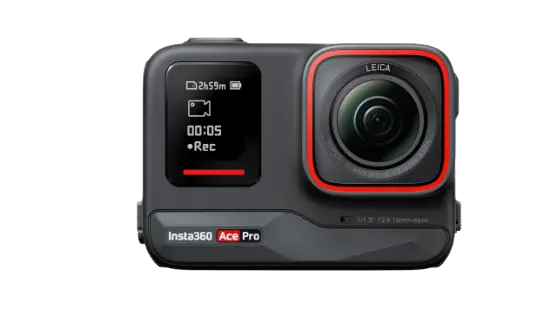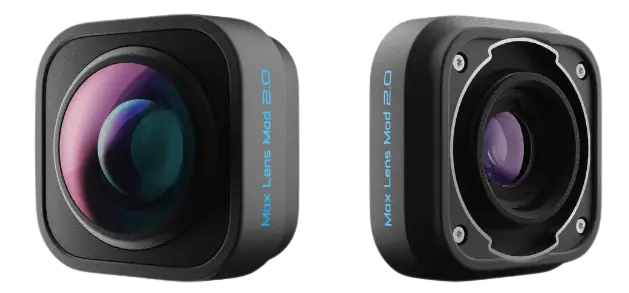If you’re looking for the best action camera, you’ve probably heard of Insta360 and GoPro. These two brands make cameras that help you capture amazing moments, whether you’re riding a bike, climbing a mountain, or just hanging out with friends. But how do you choose between the Insta360 Ace Pro and the GoPro Hero 12?
Both cameras have a lot to offer, but they do different things well. The Insta360 Ace Pro lets you film in 360 degrees, which is perfect for capturing everything around you. The GoPro Hero 12 focuses on smooth, steady shots and works great in any fast-moving action.
In this guide, we’ll break down the key features of both cameras so you can see which one fits your needs. Whether you’re into vlogging, filming sports, or capturing your travels, one of these cameras will be just right for you.
Quick Specs Overview
Let’s compare the Insta360 Ace Pro and the GoPro Hero 12 to see which camera works best for you. Both are strong, but they are built for different things. Here’s a look at the key features of each.
Insta360 Ace Pro
- Sensor: 1/2″ sensor, giving you clear video and photos.
- Resolution: 5.7K for 360° video, 4K for normal video.
- Frame Rates: Up to 100fps, great for smooth slow-motion shots.
- Weight: 160g, so it’s light and easy to carry.
- Battery Life: Lasts up to 80 minutes of filming.
- Special Feature: 360° video lets you capture everything around you.
GoPro Hero 12
- Sensor: 1/1.9″ sensor, great for low-light shots.
- Resolution: 5.3K video, 4K for high-speed action shots.
- Frame Rates: Up to 240fps, ideal for super slow-motion.
- Weight: 154g, making it slightly lighter than the Insta360.
- Battery Life: Lasts up to 90 minutes of filming.
- Special Feature: Hypersmooth stabilization keeps your shots steady.
Table: Quick Specs Comparison
| Feature | Insta360 Ace Pro | GoPro Hero 12 |
|---|---|---|
| Sensor | 1/2″ | 1/1.9” |
| Resolution | 5.7K (360°), 4K | 5.3K, 4K |
| Frame Rates | Up to 100fps | Up to 240fps |
| Weight | 160g | 154g |
| Battery Life | 80 minutes | 90 minutes |
| Special Feature | 360° video capture | Hypersmooth stabilization |
If you want to capture everything around you, go for the Insta360 Ace Pro. But if you need extra steady shots for action, the GoPro Hero 12 is the better pick.
Get a closer look at the Insta360 Ace Pro vs GoPro Hero 12 in action! Dive into our full video comparison on YouTube to see which camera truly stands out:
Design and Build Quality
Ergonomics and Portability
The Insta360 Ace Pro weighs 160 grams, making it easy to hold or mount. Its slim body feels good in hand, but the extra lens adds bulk. The GoPro Hero 12 weighs slightly less at 154 grams. Its boxy shape makes it easy to mount on gear like helmets and bikes. Both are light, but the GoPro is built for fast action.
Durability
The Insta360 Ace Pro can handle light rain but isn’t fully waterproof. The GoPro Hero 12 is waterproof up to 33 feet. You can use it for swimming, diving, or other water activities without extra gear. The GoPro is also tougher for dirt and drops.
Screen and Usability
The Insta360 Ace Pro has a small touchscreen, but it’s hard to use with gloves or underwater. The GoPro Hero 12 has a bright screen that works well in any condition. Its button layout is easy, even with gloves.
Image and Video Quality
Resolution and Frame Rates
The Insta360 Ace Pro and the GoPro Hero 12 both capture amazing videos, but they do it in different ways. The Insta360 Ace Pro can shoot 5.7K 360° video at 30fps. This means you can film everything around you, and later choose the best angle to show. It can also shoot 4K video at 60fps, which is great for regular wide-angle shots. The GoPro Hero 12 films at 5.3K at 60fps, and it can shoot 4K at up to 120fps, which works really well for action scenes or fast-moving subjects.
Low-Light Performance
The GoPro Hero 12 does better in low-light settings because of its larger 1/1.9” sensor. This means you get clearer video when filming at night or indoors. The Insta360 Ace Pro, with its 1/2″ sensor, struggles more in the dark. You might see more grain and less detail if the lighting isn’t good. So, if you often shoot in low light, the GoPro is the stronger choice.
Color Science
The GoPro Hero 12 has bright, bold colors. It makes sure your videos look lively, with good balance between light and dark areas. Its HDR mode helps bring out more detail in shadows and highlights. The Insta360 Ace Pro also gives you sharp and clear colors, but it’s more flexible because you can change the angle of your video after shooting. This gives you more creative freedom. But for straight-out-of-the-camera colors, the GoPro has the edge.
In summary, the GoPro Hero 12 is better for low light and color, while the Insta360 Ace Pro shines with its 360° video and editing options.
Stabilization and Field of View
Stabilization Technology
The Insta360 Ace Pro and the GoPro Hero 12 both have great stabilization, but they do it in different ways. The Insta360 Ace Pro uses FlowState stabilization, which works well for 360° videos. It keeps the whole scene steady, no matter which way you move the camera. This is helpful when you’re moving fast, like when you’re running or biking. The GoPro Hero 12 has HyperSmooth 6.0. It makes sure your footage stays super smooth, even when the action is fast and bumpy. Whether you’re skiing down a mountain or biking over rough terrain, the GoPro keeps things steady.
Field of View
The Insta360 Ace Pro gives you a full 360° view. It captures everything around you, so you can pick and choose what you want to focus on when editing. This is perfect for creative shots and immersive videos. The GoPro Hero 12 offers a wide-angle view, but it also has a special SuperView mode. SuperView expands the view, letting you see more of the scene in a single shot. It’s great for action sports like skateboarding or snowboarding, where you want to capture the whole environment.
Real-World Use
In real-life situations, both cameras work well, but for different reasons. If you’re doing something like mountain biking or skiing, the GoPro Hero 12 does a great job at keeping the video smooth, even when you’re moving fast. Its HyperSmooth tech is ideal for action shots. The Insta360 Ace Pro is better for vlogging or making 360° videos where you want to capture everything around you. It gives you more freedom in editing, letting you choose different angles after you record.
In short, the GoPro Hero 12 is best for fast action, while the Insta360 Ace Pro is perfect for capturing everything in 360° and editing creatively later.
360° Capture vs Standard Action Footage

Insta360 360° Capture
The Insta360 Ace Pro films in 360 degrees. This means it captures everything around you. You can shoot a fun day at the park, and later, choose the best angle to show. This makes your videos more exciting. You can create immersive experiences that make people feel like they are right there with you. When you edit, you have the freedom to reframe the shot. If your friend is laughing behind you, you can easily highlight that moment. This flexibility helps you tell great stories.

GoPro Hero 12 Traditional Capture
The GoPro Hero 12 focuses on standard action footage. It films in one direction. This is great for capturing high-speed activities like biking, surfing, or skiing. When you want to show the action, the GoPro keeps the focus on the main event. It records in high quality, so your videos look sharp and clear. This makes the GoPro perfect for action sports where every moment counts. You see the excitement unfold right in front of you.
Editing Flexibility
When it comes to editing, both cameras offer different options. The Insta360 Ace Pro gives you the chance to reframe your 360° videos after filming. You can pick any angle you like, which opens up many creative choices. This means your final video can be unique. The GoPro Hero 12 uses linear editing. You can cut and arrange your clips, but you can’t change the angle after filming. This means you need to plan your shots before you start recording.
In summary, if you want to capture everything around you and edit later, the Insta360 Ace Pro is the best choice. If you prefer clear action shots focused on one direction, the GoPro Hero 12 is your best pick.
Audio Quality and Accessories
Built-in Microphones
The Insta360 Ace Pro has built-in microphones that capture sound well. It picks up noise from all around you, which is good for 360° videos. However, when it’s windy or very noisy, the sound might not be clear. You could hear too much wind, making it hard to hear voices. The GoPro Hero 12 does better in these tough conditions. Its advanced noise reduction keeps the audio clear, even in windy places or during fast activities. This feature is great for sports, ensuring that sounds like cheers or voices come through loud and clear.
External Microphone Support
Both cameras allow you to use external microphones. This is great for vloggers or anyone who wants better sound. The Insta360 Ace Pro connects to an external microphone using an adapter. This lets you record clear audio for interviews or voiceovers. The GoPro Hero 12 also has a mic adapter, which means you can use different types of microphones. This gives you the option to create professional audio for your videos.
Modular Accessories
When it comes to accessories, both cameras offer useful options. The GoPro Hero 12 features the Media Mod. This accessory adds a better microphone, HDMI output, and more mounts for lights or other gear. This makes the GoPro a great choice for content creators. The Insta360 Ace Pro includes the invisible selfie stick. This stick disappears from the footage, creating a cool floating effect in 360° videos. It also has various mounts, so you can attach it to helmets, bikes, or other gear easily.
In summary, the GoPro Hero 12 shines with clear audio in windy conditions and flexible accessories for professional setups. The Insta360 Ace Pro excels with its 360° sound capture and unique mounting options, making it perfect for immersive videos.
Battery Life and Charging
Battery Performance
The Insta360 Ace Pro has a battery that lasts about 80 minutes when you record high-resolution video. This time can be shorter if you use special features or shoot at higher frame rates. While 80 minutes is good for many outings, you may want to carry an extra battery for longer shoots. The GoPro Hero 12 has a battery that lasts around 90 minutes when shooting in 5.3K. This extra time helps you capture more action without needing to recharge.
Charging Options
Both cameras use USB-C for charging. This is fast and easy to use. The Insta360 Ace Pro charges quickly, but it does not allow you to swap batteries as easily. If you are filming in cold weather or on busy days, having extra batteries is a smart idea. The GoPro Hero 12 lets you change the battery easily. You can swap out a dead battery for a fresh one in seconds. This feature is great for outdoor adventures when you want to keep filming. Plus, the GoPro charges quickly with the right charger, so you can get back to shooting fast.
In summary, the GoPro Hero 12 offers better battery life and quick battery swaps. The Insta360 Ace Pro works well but may require more planning for longer filming sessions.
Software and Editing
Insta360 Ace Pro Software
The Insta360 Ace Pro has a special app that makes editing videos easy. You can reframe your 360° footage. This means you can choose what to show later, like a friend laughing or a sunset. The app is simple, so even beginners can use it. You can also add music and stickers to make your videos fun. For more advanced users, the app has cool features for creative editing. It also lets you save your videos to the cloud, so you can access them from anywhere.
GoPro Hero 12 Software
The GoPro Hero 12 uses the Quik app for editing. This app is fast and user-friendly. You can quickly cut clips, add music, and use filters. It’s perfect for people who want quick edits without a lot of hassle. The Quik app is easy to learn, even for beginners. GoPro also allows you to transfer videos wirelessly and automatically upload them to the cloud. This keeps your footage safe and easy to share with friends.
Comparison of Features
Both apps are good, but they serve different needs. The Insta360 app offers more options for 360° editing, while the Quik app is best for fast, simple edits. If you want to create unique videos with multiple angles, the Insta360 Ace Pro is the way to go. If you prefer a quick editing experience, the GoPro Hero 12 is ideal.
Price and Value for Money
Cost Comparison
The Insta360 Ace Pro usually costs around $399. This price is good for anyone wanting to try 360° video without spending too much. The GoPro Hero 12 is priced at about $499. While the GoPro costs more, it is known for its strong build and high-quality video, which can make it worth the extra money for many users.
Value-Based on Features
When you think about value, it depends on what you need. The Insta360 Ace Pro offers great features for 360° capture. If you want to make videos that let people feel like they are part of the action, the Ace Pro is a smart choice. It allows you to pick and choose what to show later, which adds to its value. The GoPro Hero 12 is best for traditional action footage. It captures clear images and is built to handle tough conditions. If you enjoy extreme sports or need a reliable camera for fast action, the GoPro might be worth the higher price.
In short, the Insta360 Ace Pro gives you good features for immersive video at a lower cost. The GoPro Hero 12 justifies its higher price with excellent action footage and strong durability. Your best choice depends on what you plan to film and your budget.
Use Case Breakdown
Sports & Action Filmmaking
For sports and action filming, the GoPro Hero 12 shines. It captures sharp video in one direction. This makes it perfect for fast activities like biking, snowboarding, and surfing. The HyperSmooth 6.0 feature keeps your video steady, even when you move fast. This helps make every thrilling moment clear and exciting. The Insta360 Ace Pro can record action too, but its 360° video may not focus on the action as clearly. If you want the best footage for sports, go with the GoPro.
Vlogging & Social Media
When it comes to vlogging and sharing on social media, both cameras work well. The GoPro Hero 12 is easy to use and sets up quickly. It is great for creators on platforms like YouTube or Instagram. You can edit fast with the Quik app, making it simple to share your content. The Insta360 Ace Pro gives you fun 360° videos, which can grab attention. But it may take more time to edit and find the best angles. If you want speed and ease, the GoPro is a better choice. If you want something creative, consider the Insta360.
Travel and Daily Use
For travel and everyday use, both cameras are portable. The Insta360 Ace Pro is light and easy to carry. It captures everything around you, perfect for sharing your adventures. The GoPro Hero 12 is also compact and tough. It can handle rough weather and tough conditions well. Both cameras are simple to use, but the GoPro allows quick battery changes and fast charging, which is helpful for busy travelers.
Conclusion & Recommendation
Which Camera Should You Choose?
Pick the Insta360 Ace Pro if you want to capture everything around you. It lets you shoot in 360°, which means you don’t miss a thing. It’s great for creating videos that show every angle.
But, if you need something tough and easy to use, go with the GoPro Hero 12. It’s built for action. Whether you’re jumping, diving, or running, this camera will keep up with you and give you sharp, clear footage.
Final Thoughts
Both cameras do their job well. If you want a camera that captures all the action, choose the Insta360 Ace Pro. If you need something that can handle extreme adventures, the GoPro Hero 12 is perfect for you.


